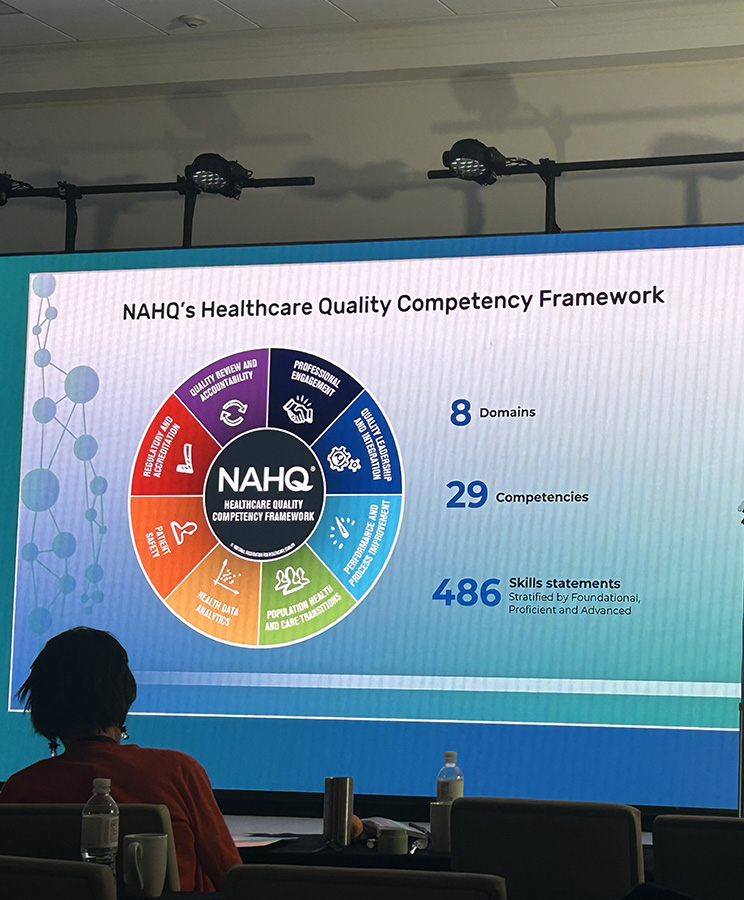The Healthcare Quality Competency Framework™
At its inception, healthcare Quality evolved organically without the benefit of a common definition or industry standard. NAHQ recognized that if the industry was to achieve its highest ambitions of Quality, Safety and Value, a framework was urgently needed to identify the full spectrum of work required for a high functioning Quality program. With this critical goal in mind, NAHQ created the Healthcare Quality Competency Framework.

Discover the Healthcare Quality Competency Framework
Click on each section to learn more.
NAHQ’s Healthcare Quality Competency Framework is copyrighted.
© 2019 National Association for Healthcare Quality
NAHQ’s Healthcare Quality Competency Framework is protected by copyright and is subject to NAHQ’s Terms of Use and Intellectual Property Permissions Policy. Unauthorized use is prohibited.
To view more details of the Framework now, please complete this form.
The Framework was created by a team of experts and validated twice in the field, establishing the definitive industry standard for workforce competencies in Quality.
- 8 domains, 29 competencies and 486 skill statements defining the category of Quality
- A common vocabulary, knowledge and toolset, ensuring the workforce is aligned
- An effective blueprint for organizations to follow with NAHQ's guidance to achieve their Quality & Safety goals
Professional engagement
Engage in the healthcare Quality profession with a commitment to practicing ethically, enhancing one’s competence and advancing the field.
- Integrate ethical standards into healthcare Quality practice
- Engage in lifelong learning as a healthcare Quality professional
- Participate in activities that advance the healthcare Quality profession
Related Products:
- HQ Concepts in Healthcare Quality and Safety for Frontline Staff
- Ethics in Healthcare Quality
- Learning Lab - Engaging and Communicating to Your Board: Demonstrating the Impact of Quality
Quality leadership and integration
Advance the organization’s commitment to healthcare Quality through collaboration, learning opportunities and communication. Lead the integration of Quality into the fabric of the organization through a coordinated infrastructure to achieve organizational objectives
- Direct the Quality infrastructure to achieve organizational objectives
- Apply procedures to regulate the use of privileged or confidential information
- Implement processes to promote stakeholder engagement and interprofessional teamwork
- Create learning opportunities to advance healthcare Quality throughout the organization
- Communicate effectively with different audiences to achieve Quality goals
Related Products:
- JHQ 309: Quality & Safety in Nursing - Recommendations from a Systematic Review
- Delivering the Case for Quality
- Learning Lab - Engaging and Communicating to Your Board: Demonstrating the Impact of Quality
Performance and process improvement
Use performance and process improvement, project management and change management methods to support operational and clinical Quality initiatives, improve performance and achieve organizational goals.
- Implement standard performance and process improvement (PPI) methods
- Apply project management methods
- Use change management principles and tools
Related Products:
- JHQ 308: General Surgery Resuscitation Preferences Documentation: A Quality Improvement Initiative
- Learning Lab - Application of Systems Thinking in Case Management
- Learning Lab - Focusing on the Intangible Factors of High-Reliability and Safety Culture
Population health and care transitions
Evaluate and improve healthcare processes and care transitions to advance the efficient, effective and safe care of defined populations.
- Integrate population health management strategies into Quality work
- Apply a holistic approach to improvement
- Collaborate with stakeholders to improve care processes and transitions
Related Products:
- Learning Lab - Application of Systems Thinking in Case Management
- Learning Lab: Updates in Infection Prevention and Control - A View from CDC
- Learning Lab: The Role of the Healthcare Quality Professional in Population Health Management
Related News:
Lessons learned in Christiana Care's hospital at home programHealth data analytics
Leverage the organization’s analytic environment to help guide data driven decision making and inform Quality improvement initiatives.
- Apply procedures for the governance of data assets
- Design data collection plans for key metrics and performance indicators
- Acquire data from source systems
- Integrate data from internal and external electronic data systems
- Use statistical and visualization methods
Related Products:
- Micro-Credential
- CPHQ Online Review Course
- HQ Concepts in Healthcare Quality and Safety for Frontline Staff
Patient safety
Cultivate a safe healthcare environment by promoting safe practices, nurturing a just culture and improving processes that detect, mitigate or prevent harm.
- Assess the organization’s patient safety culture
- Apply safety science principles and methods in healthcare Quality work
- Use organizational procedures to identify and report patient safety risks and events
- Collaborate with stakeholders to analyze patient safety risks and events
Related Products:
- HQ Concepts in Healthcare Quality and Safety for Frontline Staff
- Learning Lab: Updates in Infection Prevention and Control – A View from CDC
- JHQ 305: Interventions to Reduce Inappropriate Physical Therapy Consultation in the Inpatient Setting: A Quality Improvement Initiative
Regulatory and accreditation
Direct organization-wide processes for evaluating, monitoring and improving compliance with internal and external requirements. Lead the organization’s processes to prepare for, participate in and follow up on regulatory, accreditation and certification surveys and activities.
- Operationalize processes to support compliance with regulations and standards
- Facilitate continuous survey readiness activities
- Guide the organization through survey processes and findings
Related Products:
See all related productsQuality review and accountability
Direct activities that support compliance with voluntary, mandatory and contractual reporting requirements for data acquisition, analysis, reporting and improvement.
- Relate current and emerging payment models to healthcare Quality work
- Conduct the activities to execute measure requirements
- Implement processes to facilitate practitioner performance review activities
Related Products:
- Learning Lab: Administrative Foundations of Practitioner Peer Review
- JHQ 307: Quality Improvement Interventions to Enhance Vaccination Rates in Cancer Patients: A Systematic Review
- Learning Lab: Should I Stay or Go – ED Clinical Pathways Guiding the Way
The NAHQ Healthcare Quality Competency Framework™ is endorsed by The Joint Comission


Adopted by industry leaders


“I’m excited that I have the [Healthcare Quality Competency] Framework that assures we have the competency to deliver on our amazing vision and mission.”
Robin Betts, MBA-HA, RN, CPHQ
VP, Safety, Quality and Regulatory Services
Kaiser Permanente, Northern California Region
Peer reviewed articles about the Healthcare Quality Competency Framework
Why Competency Standardization Matters for Improvement: An Assessment of the Healthcare Quality Workforce
Healthcare transformation requires a healthcare quality workforce with the requisite expertise to lead, oversee, and implement positive change within …
Source: Journal for Healthcare Quality, September/October 2021
Workforce Competencies for Healthcare Quality Professionals: Leading Quality-Driven Healthcare
As healthcare delivery systems increasingly adopt models designed to reward cost-efficient and high-quality care, the demand for expertise in …
Find out how NAHQ can help your organization implement our Framework with Workforce Accelerator
The history behind the Healthcare Quality Competency Framework
Today, the Framework is the industry standard, representing the full spectrum of work required for achieving Quality excellence. In 2016, however, there was not yet a common definition, much less common standard, for Quality competencies. As the leader at the forefront of advancing Quality & Safety, NAHQ recognized the urgency of the need and set out to create the detailed, in-depth Framework that was required to achieve our highest aspirations in healthcare – Quality, Safety and Value.
We created the Healthcare Quality Competency Framework in three phases: content development, content evaluation and user evaluation.
Content development
First, we assembled a team of experts. An oversight team representing all areas of healthcare Quality, including a CPHQ® expert and an academic specialist in Quality & Safety, were assigned the task of developing NAHQ’s Healthcare Quality Competency Framework. They received additional support from a PhD-educated consultant and six internal work groups who together developed and vetted content.
The final Framework today consists of 8 domains, 29 competencies and 486 skills, categorized into three proficiency levels: foundational, proficient and advanced.
Content evaluation
Once created, NAHQ’s Healthcare Quality Competency Framework was evaluated by top authorities in the field. An education consultant designed a survey and included only the 8 domains and 29 competencies. The goal was to review and evaluate content until it was ready for healthcare Quality professionals across the continuum.
User evaluation
When the Framework evaluation process was approved, NAHQ engaged survey experts to design a self-assessment tool for evaluating the consistency of the Framework content compared with Quality practice and sent it to a wide range of participants. The end result? The findings showed the self-assessment tool consistently provided accurate information on competencies relevant to Quality practice. The Framework was ready to serve its purpose as the industry standard.
Download the Healthcare Quality Competency Framework
Thank you for your interest in the Healthcare Quality Competency Framework.
The HQCF serves as the industry standard defining the spectrum of work required for a high functioning quality program to achieve Quality, Safety and Value.







